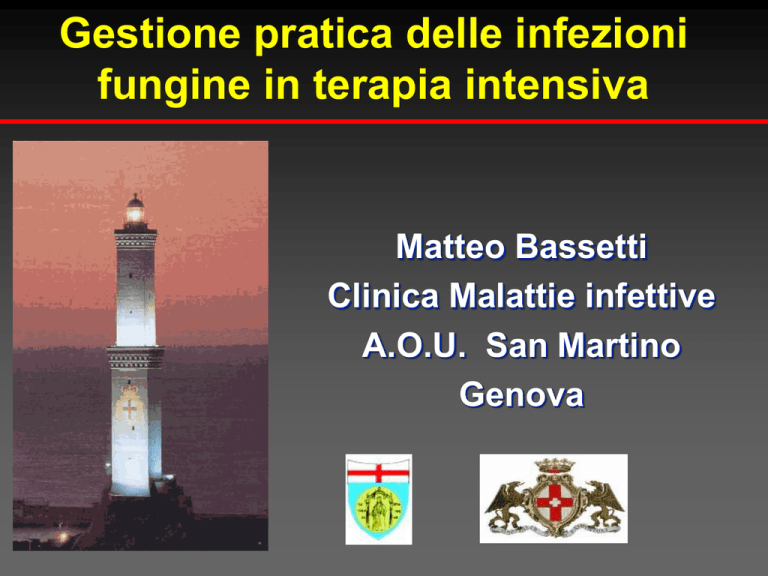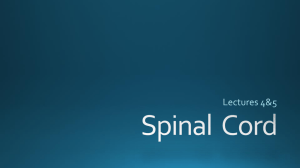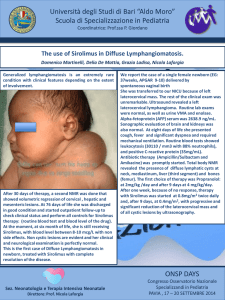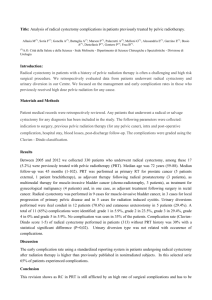Document
advertisement

Gestione pratica delle infezioni fungine in terapia intensiva Matteo Bassetti Clinica Malattie infettive A.O.U. San Martino Genova Hospital mortality (%) Relationship between hospital mortality and the timing of antifungal treatment 35 30 25 20 15 10 5 0 < 12 12–24 24–48 > 48 Delay in start of antifungal treatment (hours) Morrell M, et al. Antimicrob Agents Chemother 2005; 49:3640–5 Mortality associated with Candida infections in ICU Variable Mortality rate (%)* Department Medical Surgical 58 37 Candida species C. albicans C. parapsilosis C. glabrata 36 33 69 Overall 41 *Crude mortality. Tortorano AM, et al. 3rd TIMM. Turin, Italy,28–31 Oct 2007; Oral communication O.07 Fluco in High-risk SICU patients Proportion infected 260 surgical ICU patients (stay > 3days) randomized to double-blind oral antifungal prophylaxis 0.6 Placebo 0.5 0.4 0.3 Fluconazole 0.2 0.1 p < 0.01 by log-rank test 0 7 14 21 28 Days Pelz Ann Surg 233:542-548, 2001 Prophylaxis in the (S)ICU Pelz et al., Ann Surg 233:542-548, 2001 - Fluco vs. placebo in extremely high risk ICU - Placebo: 16% rate of invasive candidiasis This rates equals that in BMT - Fluco 400/d: 8% rate - P < 0.01 A very unusual population - Median APACHE III = 60, lots of liver transplant - Applicability in most ICUs is unclear Sandven et al.: Low-risk surgical patients Double-blind single-dose antifungal prophylaxis in 109 patients with intra-abdominal perforation 60 % NS 50 43% 40 30 34% NS NS 20 10 0 14% 10% 10% Emergence of colonization 7,5% Complications Death Sandven CCM 2002 RESULTS OF CANDIDA PROPHYLAXIS IN ICU PATIENTS Garbino et al. Intensive Care Med 2002;28:1708-1717 P<0.01 100 % P<0.001 80 Fluconazole 100 mg/d Placebo 78% 66 53 60 NS 39 41% 40 20 0 30% NS 7% 3% P=0.014 0 6% Success Emergence Death Invasive Candidemia of colonization from candidosis prophylaxis by Candida any cause Antifungals in critically ill and surgical patients: meta-analysis Impact on Candidal infections Impact on mortality NNT= 94 NNT in high-risk= 9 NNT in low risk= 188 Playford et al. JAC 2006; 57: 628–638 PROPHYLACTIC FLUCONAZOLE….. • HAS ELIMINATED CANDIDA COLONISATION! More patient comfort ……..BUT • HAS ELIMINATED CANDIDA COLONISATION! More patient comfort • DID NOT REDUCE MORTALITY • HAS SELECTED RESISTANT CANDIDA SPECIES ◊ incidence of candidemia episodes/10 000 patient-days/year; ■ DDD’s of fluconazole x 100 pts/days Figure 1. Shift from CA to CNA 3,50 2000 1800 Incidence of candidemia 1600 2,50 1400 1200 2,00 1000 1,50 800 600 1,00 400 Fluconazole DDD's x 100 pts/days 3,00 0,50 200 0 0,00 Y 1999 Y 2000 Y 2001 Y 2002 Y 2003 Years observed Bassetti M et al. BMC Infect Dis 2006; 10: 621 Restriction of prophylactic fluconazole use Bassetti et al – JAC 2009; 64:625-629 Med-surg ICU (500 adm./an) 108 months (Jan 99-Dec 2007) Overall prevention of NI unchanged 213 candidemia (1.42/10 000 patient-days) albicans (46%), parapsillosis (22%), glabrata 13% Intervention: Janv 1999-Janv 2003: Extensive Prophylaxis Janv 2003-Dec 2007:Incitation not to do Statistical analysis: Segmented linear regression Incidence of Candidemia and fluconazole in ICU Stop fluco Stop fluco X Non-albicans candidaemia C. albicans candidaemia Bassetti M et al. J Antimicrob Chemother 2009: 64:625-9. So what about preemptive therapy with predicitive rules? Candida Score Leon C et al. Crit Care Med 2006; 34:730- 737 Candida score validation León C et al Crit Care Med. 2009;37:1624-33 Other Predictive rules The best performing predictive rule was: Patients in the ICU >4 days AND Any systemic antibiotic (days 1–3) OR Central venous catheter (days 1–3) AND at least two: Total parenteral nutrition (days 1–3) Any dialysis (days 1–3) Major surgery (days -7–0) Pancreatitis (days -7–0) Any use of steroids (days -7–3) Immunosuppressive agents (days -7–0) Ostrosky-Zeichner et al. Eur J Clin Microbiol Infect Dis 2007 (13)-β-D-GLUCAN CONCENTRATIONS 600 BG values Pg/ml 500 _____ 400 300 _____ 200 100 _____ _____ 0 CBSI PCBSI NCBSI CONTROLS CBSI: proven Candida BSI PCBSI: possible Candida BSI NCBSI: no Candida BSI CONTROLS: healthy volunteers Horizontal bars indicate median values Del Bono V et al. 49th ICAAC, 2009 Criteria to start pre-emptive antifungal therapy Pz. In ICU ≥ 4 days. Abx in the last 7 days O CVC from 7 days •Start antifungal 2 of the following: •Total parenteral nutrition (days 1–3) • Any dialysis (days 1–3) • Major surgery (days -7–0) • Pancreatitis (days -7–0) • Any use of steroids (days -7–3) • Immunosuppressive agents (days -7–0) Candida colonization or (1-3)-ß-D-glucan Different antifungal strategies Bassetti M et al. Crit Care 2010 December 1 Bassetti M et al. Crit Care 2010 December 1 Empiric use of antifungals in the ICU setting Still no good data clinical for empiric antifungal therapy in the non-neutropenic population Follow fundamental principles for treating candidemia Utilize serologic markers, surveillance cultures, and/or a ‘scoring system’ to determine most appropriate use Duration of therapy not specifically addressed, although the implication is to curtail therapy in stable patients absent positive culture/serologic data Pappas PG, et al. Clin Infect Dis 2009; 48: 503–35 15 July 2008 Double-blind, placebo-controlled trial with fluconazol 800 mg (x 14d) in 270 adult IC-patients: 4 days of fever (>38.3°C) ICU stay > 96h APACHE II ≥ 16 Broad spectrum antibiotics Central line ≥ 24h Fluconazol n (ITT) Success 133 44 (36%) Invasive mycosis 6 (5%) 30-Day mortality 29 (24%) Placebo 95% CI / P-value 137 48 (38%) 11 (9%) 22 (17%) 0.69–1.32; P = 0.78 RR 0.57; 0.22–1.49 RR 1.36; 0.82–2.24 Schuster et al, Ann Intern Med 2008 Susceptibility profile of Candida species Dodds Ashely ES et al. Clin Infect Dis 2008 ; 43: S28–39 Distribution of the Candida spp. In vitro susceptibility to fluconazole 305 isolates identified, 210 isolates tested 17% fluconazole-R or S-DD (using validated susceptibility testing methods) Species Distribution Candida albicans Candida glabrata Candida parapsilosis Candida krusei Candida tropicalis Candida kefyr Candida guilliermondii Candida lusitaniae Other Candida species Total 174 (57%) 51 (17%) 23 (7.5%) 16 (5.2%) 15 (4.9%) 11 (3.6%) 5 (1.6%) 2 (0.7%) 8 (2.6%) 305 In vitro susceptibility to fluconazole n tested S S-DD or R 113 96% 4% 38 50% 50% 19 90% 10% 6 17% 83% 14 86% 14% 9 100% 0 5 80% 20% 2 100% 0 4 50% 50% 210 83% 17% Leroy et al. Crit Care Med 2009; 37:1612–1618 In vitro susceptibility to fluconazole in patients naïve and previously exposed to azoles in ICU Leroy et al. Crit Care Med 2009; 37:1612–1618 Initial empiric antifungal treatment (n=271) Fluconazole Caspofungin Voriconazole Caspofungin + Fluconazole Liposomal amphotericin B Amphotericin B deoxycholate Itraconazole Caspofungin + Voriconazole Amphotericin B lipid complex Amphotericin B deoxycholate + Fluconazole Amphotericin B deoxycholate + Flucytosine Amphotericin B deoxycholate + Voriconazole Liposomal amphotericin B + Caspofungin Liposomal amphotericin B + Flucytosine 65,7% 18,1% 5,5% 3,0% 2,2% 1,1% 1,1% 1,1% 0,4% 0,4% 0,4% 0,4% 0,4% 0,4% Leroy et al. Crit Care Med 2009; 37:1612–1618 Risk factors for fluconazole resistance Odds ratio 95 percent confidence Limits P - value Neoplasia 2.9 1.4 – 5.9 ≤ 0.005 Prior fluconazole use 3.8 1.7 – 8.2 ≤ 0.001 Cisterna R et al. J Clin Microbiol 2010; doi:10.1128/JCM.00920-10 IDSA- Candidemia in nonneutropenic If species is unknown, either fluconazole (800mg loading dose, 400 mg daily) or an echinocandin is appropriate initial therapy for most adult patients (AI) An echinocandin is favored if - Moderately severe to severe illness, - Recent azole use for treatment or prophylaxis (AIII), or - Isolate is known to be C. glabrata or C. krusei (BIII) Fluconazole for patients who are - less critically ill and - who have no recent azole exposure (AIII). Move from candin to fluconazole when isolates likely susceptible to fluconazole (e.g., C. albicans) and patient is clinically stable (AIII) Remove or exchange intravenous catheters Treat for two weeks after clearance of bloodstream Treatment in ICU Empirical treatment(IA) Azole exposure No (A-III) yes (A-III) High risk of C. glabrata or krusei ? Or severe (AIII) No fluconazole yes echinocandin Clinical Infectious Diseases 2009; 48:503–35 Secondary adapted to results. Invasive candidiasis IDSA 2009 Clinical Infectious Diseases 2009; 48:503–35 Clinicaly stable Yes No Known fungi C. Glabrata (B-III) Sensitive to fluconazole C krusei (A-I) C. parapsilosis Yes (B-III) fluconazole No AmB-L echinocandin Major changes from the previous IDSA Guidelines (2004) Emphasis on fluconazole and echinocandins as the ‘preferred choices’ for proven/suspected IC De-emphasis on AmB and LFAmB under most circumstances Concept of step down therapy is strongly encouraged There is little distinction made between the echinocandins Antifungal drug studies candidaemia P=.39 P=.04 P=.09 73% 69% P=.82 71% 72% P=.27 74% P=.009 76% 60% 56% Fluconazole AMB Flu AMB + Flu AMB Caspofungin Phillips, 1995 Rex, 2003 Mora-Duarte, 2002 Amfotericine B Fluconazol Voriconazole Fluconazole Anidulafungin L-Amfotericine B Micafungin Micafungin Caspofungin Caspofungin Amfotericine B Amfotericine B + Flu Fluconazol (800) 53% Amfotericine B Fluconazol 50% 72% 72% 70% 62% P=.64 Micafungin Caspofungin Anidulafungin Voriconazole Micafungin Liposomal AMB Fluconazole AMB->Flu Pappas, 2007 Kuse, 2007 Reboli, 2007 MITT - Investigator-Assessed Response at End of Treatment (%) Kullberg, 2005 Chemical Structures Caspofungin Micafungin Anidulafungin Glarea lozoyensis Coleophoma empetri Aspergillus nidulans HO H2N NH HO N HO O OH NH H3 C H2N O O HN H H NH O H H H N O OH N H3C CH3 HO O HO CH3 O O NH CH3 HO O N H N OH HN O NH CH3 N H N O O H3C OH OH OH OH O O O HO HO O HO OH O O H3C O O OH CH3 N OH HN O NH O N H S O N OH NH H3C NH O NH H2N HO O HO O OH O H OH O HO HO H3C Side chains are key determinants of lipophilicity, solubility, antifungal activity, and toxicity Adapted from Micafungin US Prescribing Information; Anidulafungin US Prescribing Information; Debono M, Gordee RS. Annu Rev Microbiol. 1994;48:471–497; Debono M et al. J Med Chem. 1995;38:3271–3281. Attività in vitro delle echinocandine nei confronti di Candida spp. MIC90 (µg/ml) Organismo Numero di isolati Micafungina Caspofungina Anidulafungina C. albicans 2.869 0.03 0.06 0.06 C. parapsilosis 759 2 1 2 C. glabrata 747 0.015 0.06 0.12 C. tropicalis 625 0.06 0.06 0.06 C. krusei 136 0.12 0.25 0.06 C. guilliermondii 61 1 1 2 C. lusitaniae 58 0.25 0.5 0.5 C. kefyr 37 0.06 0.015 0.12 C. famata 24 1 1 2 Candida spp. 30 0.5 0.25 1 Pfaller MA, et al. J Clin Microbiol 2008; 46:150–6 Pharmacology: Metabolism, Elimination, Bioavailability, and Protein Binding Caspofungin Metabolism Elimination/excreti on Micafungin Hepatic metabolism Hepatic metabolism by hydrolysis and by arylsulfatase and N-acetylation catechol-Omethyltransferase Spontaneous nonhepatic chemical degeneration Anidulafungin Nonhepatic chemical degradation Urine 41% Feces 34% Urine + feces 82.5% Feces 71% Urine <1% Feces ≈30% Protein Binding 97% >99% >99% Oral Bioavailability <5% <5% <5% No No No Dialyzable Adapted from Micafungin US Prescribing Information; Anidulafungin US Prescribing Information; Dodds Ashley ES et al. Clin Infect Dis. 2006;43:S28–S39. Echinocandin studies Mora-Duarte Kuse Reboli Caspo AMB Mica L-AMB Anidu Fluco Apache <20 80,7 80 72 76 80 83 Apache > 20 19,3 20 28 24 21 17 Prior antifungal therapy 56 67 NA NA NA NA C. albicans 35 54 42,6 44,2 64 59 C. parapsilosis 19,8 18,3 18,3 15,8 10 14 C. glabrata 12,8 9,2 11,4 7,9 16 25 C. krusei 4 0,9 3 3,7 Excl.. Excl. Neutropenia (< 500) 12,8 8,7 12 7,9 2 3 Fav. response (EOT) 80,7 64,9 89,6 89,5 75,6 60.2 Mortality 34,2 30,4 NA NA 22,8 31,4 Echinocandins Approved Indications EMEA Empirical Therapy in Febrile Neutropenic Pts Therapy in Proven Infections Therapy of Oesophageal Candidiasis Prophylaxis of CandidaInfections in HSCT Patients Candida spp. Aspergillus spp. Yes Yes (Salvage therapy) No No Yes Yes Yes (Salvage Therapy) No No No Yes No No Children No Yes No Yesa Yes Adults No Yes No Yes Yes Caspofungin Children Adults Yes Anidulafungin Adults No Micafungin* * The decision to use micafungin should take into account a potential risk for the development of liver tumours. Micafungin should therefore only be used if other antifungals are not appropriate Candida colonization Is frequent in ICU patients The gut is the main portal of entry in neutropenic patients The skin is an important source of candidemia in non-neutropenic patients Tracheal colonization reflect oropharyngeal colonization and is not associated with candidal pneumonia in non- neutropenic ICU patients 1587 admissions 301 (19%) died 232 autopsies 135 (58%) with 97 (42%) without pneumonia pneumonia 77 patients with Candida in LRT 58 patients with Candida in LRT 0 Candida pneumonia 0 Candida pneumonia Is Candida colonization of CVC in noncandidemic an indication for antifungals? 58 pts ( 91% in ICU) Independent predictors for outcome: - ultimately fatal underlying disease (P = 0.02) - severe sepsis, septic shock or multiorgan failure (P = 0.05). Antifungal therapy does not seem to have a significant influence on clinical outcome Perez-Parra A et al. Intensive Care Med 2009; 35:707–712 OUTCOME OF CANDIDEMIA IN THE UK 1997-99 IMPACT OF CATHETER MANAGEMENT 58% No line removal + antifungal (n=29) 31% Day 30 mortality overall (n = 163) Line removal + antifungal (n=91) No treatment (n=31) 26% 14% Kibbler et al. J Hosp Infect 2003; 54:18-24 Early removal of central venous catheter in patients with candidemia does not improve outcome Nucci M et al. Clin Infect Dis 2010; 51:295–303 Early removal of central venous catheter in patients with candidemia does not improve outcome Nucci M et al. Clin Infect Dis 2010; 51:295–303 Candidemia in cancer patients: Impact of early removal of catheter Liu CY et al. J Infect 2009; 58:154-160 OR (95% CI) P 2.35 (1.09-5.10) 0.03 Infection biofilm-forming 2.33 (1.26-4.30) Candida species 0.007 APACHE score 0.001 Inadequate antifungal therapy 1.03 (1.01-1.15) Tumbarello et al JCM 2007 Biofilm Production by Candida spp 100 P = 0,04 90 80 70 60 50 40 30 20 10 sil os is .p ar ap .g la br at a C .tr op ica lis C C .a lb ic an s 0 Mortality by Biofilm-Producing Isolates 100 90 80 70 60 50 40 30 20 10 0 P<0,001 Biofilm-positive Biofilm-negative er O th ra ta C .g la b lis pi ca .tr o C ra p .p a C C .a lb i ca si lo ns si s Mortality (%) P=0,003 Activity against Candida biofilms L-AMB L-AMB Kuhn et al AAC 2002 46:1773


